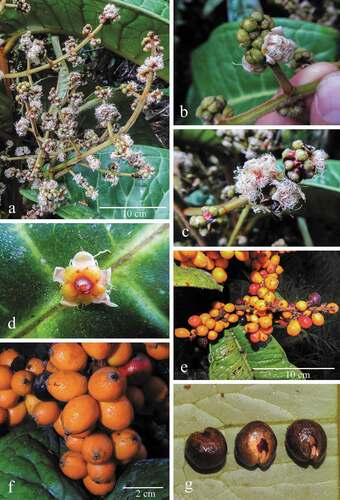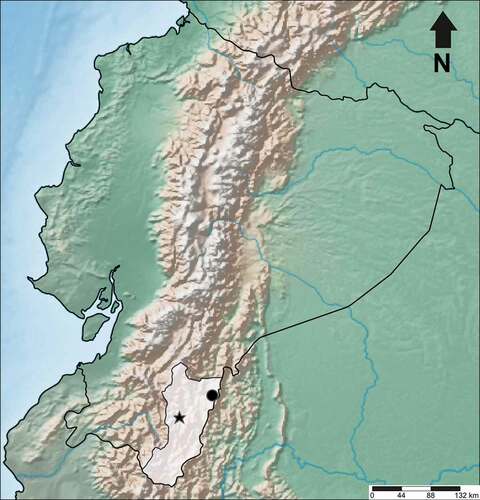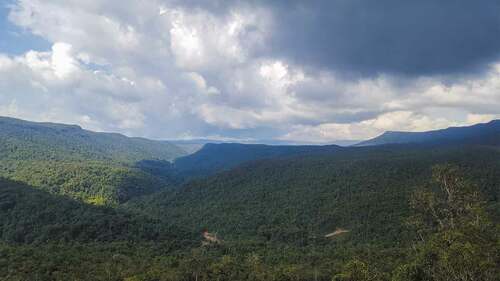ABSTRACT
Myrcia machinazana, a new species from southern Amazonia in Ecuador is described and illustrated; additionally a distribution map is presented and its conservation status and relationships with other species are discussed. This new species is similar to Myrcia gigantifolia, but differs by its reddish to dark-brown indumentum on new growth (vs. new growth glabrous in M. gigantifolia) and dense panicles with compactly arranged flowers and fruits (vs. panicles lax, flowers and fruits loosely arranged in M. gigantifolia). A key to the Ecuadorian species of Myrcia is provided.
Resumen
Myrcia machinazana, una nueva especie de la Amazonia sur del Ecuador, es descrita e ilustrada; adicionalmente se presenta un mapa de distribución y se discute su estado de conservación y sus relaciones con otras especies. Esta nueva especie es similar a Myrcia gigantifolia, pero difiere por su indumento rojizo a café-oscuro en los nuevos brotes (vs. nuevos brotes glabros en M. gigantifolia) y densas panículas con las flores y frutos compactos (vs. panículas laxas, las flores y frutos sueltos en M. gigantifolia). Se presenta una clave para las especies Ecuatorianas de Myrcia.
Introduction
Myrcia DC., one of the largest genus of Neotropical Myrtaceae, occurs from Mexico, Central America, the Caribbean, to South America [Citation1]. Molecular phylogenetic studies [Citation2,Citation3] suggest a broad circumscription (Myrcia s.l.), including, however, the distinctive genus Calyptranthes Sw. as a section. Myrcia, as we recognize it [Citation1], comprises ca. 500 or more species. In Ecuador, they are characterized by the usually opposite leaves, trichomes simple or dibrachiate, inflorescences paniculate; calyx either open, with five free lobes or closed and tearing into irregular, deciduous lobes; petals usually five; stamens numerous; ovary usually two-locular, with two ovules per locule; stigma punctiform; fruits usually crowned by the calyx lobes; seeds 1 or 2, the seed coat membranous or carthaceous; embryo myrcioid, the cotyledons leafy and folded, the radicle elongate, equaling the cotyledons in length [Citation1].
In Ecuador, 21 species of Myrcia have been recorded, seven of them are endemics, including this new species. The distribution of Myrcia in Ecuador ranges from 200 to 3000 m.a.s.l; its highest diversity is found in the southern province of Zamora-Chinchipe (10 species), followed by the central and north Amazonian provinces of Sucumbios, Napo, Pastaza and Orellana with six to nine species [Citation1].
During recent botanical explorations in the Machinaza river basin, an undercollected area in the Zamora-Chinchipe province, we collected a new species of Myrcia with large leaves. We present a taxonomic description for this new species, images for all its structures, and a distribution map; additionally its conservation status and relationships with other species are discussed.
Methods
Materials and methods
Fieldwork: Recently, during floristic inventories carried out in October 2019 and February 2020 in the Fruta del Norte mining concession, Zamora-Chinchipe province, we were fortunate to obtain flowers and mature fruits and close-up pictures of all structures for this new species.
Identification and Morphological analysis: We consulted pertinent literature, specimens examined at F and QCA herbaria, and high resolution images of type material of Neotropical taxa (Tropicos database, https://www.tropicos.org/ [Citation4] and the JSTOR Global Plants website http://plants.jstor.org [Citation5]). Fresh material and pictures were the basis for the detailed morphological description of this species. All measurements were made in fresh, and fine observations and measurements of reproductive structures were made with the aid of a stereo-microscope.
Taxonomy
Myrcia machinazana
Á.J. Pérez & M.L. Kawas., spec. nov. ()
Figure 1. Myrcia machinazana. (A) Habit; (B) Trunk; (C, D) Pubescence; (E) Leaf, adaxial side; (F) Branch with inflorescences. From A.J. Pérez et al. 11623. Photographs by Álvaro J. Pérez

Figure 2. Myrcia machinazana. (A, B, C) Details of the inflorescence with flowers closely compact; (D) Rear view of the flower; (E) Infructescence; (F) Fruits; (G) Seeds. A, B, C, D from A.J. Pérez et al. 11623, E, F, G from A.J. Pérez et al. 11616. Photographs by Álvaro J. Pérez

Type: – ECUADOR. Zamora-Chinchipe: camino Los Encuentros – El Pindal – Campamento Las Peñas, lado derecho del camino entre el portal y el campamento, a ca. 4 km del campamento, 1390 m, −3.7605, −78.5098, 26 January 2020 (fl), Á.J. Pérez, N. Zapata & E. Rea 11623 (Holotype QCA! 243317, mounted in 2 herbarium sheets; Isotype F!, mounted in 2 herbarium sheets).
Myrcia machinazana is similar to M. gigantifolia M.L. Kawas. & Á.J. Pérez, differing in reddish- to dark-brown indumentum on new growth (vs. new growth glabrous in M. gigantifolia) and dense panicles with compactly arranged flowers and fruits (vs. panicles lax, flowers and fruits loosely arranged in M. gigantifolia).
Trees 12 m high, ca. 8 cm dbh, monocaulus or branching at the apex of the trunk with few (−4) short branches; indument reddish-brown to dark-brown on new growth, lower surface of leaves, petioles, inflorescences, and fruits. Leaves subsessile, the blades lanceolate to ovate, coriaceous, 40–70 × 16–32 cm, the upper surface olive-green and puberulous to glabrous, the lower surface light green, brownish-pubescent throughout but densely on venation; glands numerous, punctiform, salient on both surfaces; midvein and secondary veins impressed above and convex below; marginal vein 1, 2–10 mm from blade margin, similar in prominence to the lateral veins; apex abruptly acuminate to acuminate; base cordate, amplexicaul. Inflorescences subterminal, paniculate, 24–36 cm long, multiflorous, the flowers closely compact at the apex of the axes, the axes pubescent; bracts and bracteoles lance-ovate to lanceolate, 3–15 mm long, deciduous. Flower buds subglobose, 3–4 mm long, the hypanthium not prolonged above the ovary; calyx lobes 5, ca. 3 × 3 mm, broadly rounded at apex, pubescent; petals 5, suborbicular, ca. 5 × 4 mm, glabrous within, sericeous without, glands numerous, punctiform; stamens numerous, the filaments 4–9 mm long, the anthers ca. 0.5 mm long; style ca. 10 mm long, the stigma punctiform; disk 5–6 mm diam., densely pubescent; ovary two-locular, with two ovules per locule. Fruits ellipsoid, 1.5–2 × 1–1.5 cm, red to dark purple, puberulous; seeds 1 or 2, 1–1.5 cm long, the seed coat membranous; embryo myrcioid, the cotyledons leafy and folded, the radicle elongate, equaling the cotyledons in length.
Distribution, habitat and ecology
Endemic to the Cordillera del Cóndor region, along the Machinaza river basin in Zamora-Chinchipe province. This species is known only from the type locality and surrounding areas along the road Los Encuentros – El Pindal – Campamento Las Peñas, at 1300–1500 m in elevation (). The habitat is a mature forest with low human intervention, where approximately 10 adult individuals were observed, but no seedlings nor juveniles. According to the Ministerio del Ambiente de Ecuador [Citation6] this locality lies within a much larger zone dominated by evergreen low montane forest of the Cordilleras Cóndor-Kutukú (). According to the field observations, it grows associated with tree species, some of them endemics, including Brosimum utile (Kunth) Oken, locally known as sandi, Elaeagia mariae Wedd., named as barniz, Magnolia arroyoana Molinari and Magnolia yantzazana F. Arroyo, known as cucharillos, Graffenrieda spp., and the palms Euterpe precatoria Mart., Geonoma spp. and Socratea cf. salazarii H.E. Moore.
Figure 3. Distribution map of Myrcia machinazana in the Zamora-Chinchipe province, south Ecuador. The star represents the location of Zamora city

The Cordillera del Cóndor is a poorly explored region that extends ca. 150 km north to south from Ecuador to Peru. This mountain range is considered an eastern extension of the Andean chain that was uplifted ca. five million years ago. Biological explorations in this area have revealed a rich species biodiversity with high endemism. In particular, the region harbours many taxa disjunct with the Guiana Shield of northern South America due to their shared geology. Cordillera del Cóndor contains a high concentration of species new to science, and many are still to be discovered [Citation7–12].
Etymology
The specific epithet refers to its type locality, in the forests surrounding the Machinaza river basin.
Phenology
This species has been collected flowering in January and sets fruits in October.
Conservation status
Following IUCN [Citation13] criteria the status is Critically Endangered B1ab(i,ii,iii). The criteria justifying this classification include the species’ small population size, with only 12 total known individuals, an estimated area of occupancy of 15 km2, continuously fragmented habitat due to land use change for mining activities. More exploration is needed to determine its real population size and the occupancy area.
Discussion
Myrcia machinazana belongs to sect. Myrcia due to the calyx with five distinct lobes and hypanthium not prolonged above the ovary. Myrcia machinazana and M. gigantifolia are easily recognized from the other species of the genus by their unique giant leaves (longer than 30 cm and wider than 15 cm) with impressed venation [Citation14]; in both species, the leaves are morphologically similar. These two species differ mainly in the reddish- to dark-brown indumentum on new growth (vs. new growth glabrous in M. gigantifolia) and dense panicles with compactly arranged flowers and fruits (vs. panicles lax, flowers and fruits loosely arranged in M. gigantifolia). Additionally, M. gigantifolia grows only in varzea forest along the Tiputini and Yasuní rivers, while M. machinazana grows on terra firme forest with loamy sandstone and granite soils.
Additional specimens examined. ECUADOR
Zamora-Chinchipe: camino Los Encuentros – El Pindal – Campamento Las Peñas, lado izquierdo del camino entre el portal y el campamento, a ca. 3 km del campamento, 1433 m, −3.7706, −78.5099, 27 October 2019 (fr), Á.J. Pérez & A. Fernández 11616 (QCA! 243316, mounted in two herbarium sheets; F!, mounted in 2 herbarium sheets).
Key to Ecuadorian species of Myrcia [Citation1], modified to include Myrcia machinazana:
1a. Leaves in whorls of 4. M. verticillata M. L. Kawas. & B. Holst
1b. Leaves opposite.
2a. Leaf blades > 30 cm long and > 15 cm wide.
3a. Plants mainly glabrous; panicles lax, the flowers and fruits loose. M. gigantifolia M. L. Kawas. & Á. J. Pérez
3b. Plants with reddish-brown to dark-brown indument on new growth, lower surface of leaves, inflorescences, and fruits; panicles dense, with closely compact flowers and fruits. M. machinazana Á. J. Pérez & M. L. Kawas., sp. nov.
2b. Leaf blades usually to 30 cm long and to 15 cm wide.
4a. Leaf blades 12–30(–35) × 3.5–15 cm long, mostly > 15 cm long.
5a. Leaf blades usually oblanceolate to obovate or ovate; calyx lobes wider than long, truncate. M. neesiana DC.
5b. Leaf blades narrowly elliptic to elliptic; calyx lobes longer than wide, acute to obtuse.
6a. Leaf venation salient, but appearing strongly sulcate above, the midvein a narrow ridge; marginal veins 2, the innermost ca 3–5 mm from margins; leaf base obtuse to subcordate. M. crassimarginata McVaugh
6b. Midvein impressed above, the lateral and marginal veins plane to impressed above; marginal vein 1, 1–2 mm from margins; leaf base cuneate to obtuse. M. magnoliifolia DC.
4b. Leaf blades 1.5–15 cm long.
7a. Calyx closed, at anthesis tearing into irregular, unequal lobes, deciduous.
8a. Midvein of leaves convex on upper surface; apex caudate-acuminate. M. neoschomburgkiana E. Lucas & C. E. Wilson
8b. Midvein of leaves impressed on upper surface; apex abruptly acuminate to acuminate. M. umbraticola (Kunth) E. Lucas & C. E. Wilson
7b. Calyx open, the lobes 5, equal, persistent.
9a. Midvein on the upper leaf surface convex; flower buds glabrous. M. guianensis (Aubl.) DC.
9b. Midvein on the upper leaf surface impressed; flower buds pubescent, at least on the hypanthium.
10a. Leaf blades to two times longer than wide, elliptic, broadly elliptic, suborbicular, or ovate; apex obtuse to rounded; base obtuse, rounded or broadly subcordate.
11a. Leaf blades 1.7–3 × 1.2–2.8 cm, tomentose, the venation conspicuously salient and reticulate below; inflorescences tomentose. M. lojensis B. Holst & M. L. Kawas.
11b. Leaf blades 4–12 × 3–9 cm, pubescent to glabrous, the venation slightly salient below; inflorescences pubescent to puberulous.
12a. Leaf blades pubescent to puberulous, obtuse at base; lateral veins strongly impressed above, the upper surface bullate; petioles 7–10 mm long; panicles axillary; 2300–2750 m elevation. M. fasciata McVaugh
12b. Leaf blades glabrous, rounded to subcordate at base; lateral veins slightly salient above; petioles 1–3 mm long; panicles subterminal; 900–1300 m elevation. M. subcordifolia B. Holst & M. L. Kawas.
10b. Leaf blades more than two times longer than wide, narrowly elliptic to elliptic, lanceolate or obovate; apex acute to acuminate, abruptly acuminate, or caudate; base cuneate to obtuse.
13a. Leaf blades drying dark- to reddish-brown; calyx lobes wider than long, truncate.
14a. Branches, leaves, inflorescences, and flowers glabrescent; flower buds to 3 mm long. M. aliena McVaugh
14b. Trichomes on branches, leaves, inflorescences, and flowers usually persistent; flower buds 4–5 mm long. M. neesiana DC.
13b. Leaf blades usually drying yellowish-green, olive-green or brownish; calyx lobes longer than wide, acute to obtuse, not truncate.
15a. Flower buds with hypanthium and calyx lobes distinctly pubescent to hirsute.
16a. Plants hirsute; inflorescences conspicuously bracteate. M. bracteata (Rich.) DC.
16b. Plants densely pubescent; inflorescences not conspicuously bracteate.
17a. Leaf blades obtuse at base, acute to short-acuminate at apex; flower buds 3–4 mm long. M. mollis (Kunth) DC.
17b. Leaf blades cuneate at base, acute to obtuse at apex; flower buds ca 2 mm long. . … . M. tomentosa (Aubl.) DC.
15b. Flower buds with hypanthium distinctly pubescent, the calyx lobes pubescent to glabrous.
18a. Upper leaf surface impressed-punctate, with indistinct lateral veins.
19a. Leaf blades narrowly elliptic or lanceolate, 7–12.5 × 3–4 cm, cuneate at base; petioles 4–6 mm long. M. paivae O. Berg
19b. Leaf blades lanceolate to ovate, 2.5–5 × 1–2 cm, obtuse at base; petioles 2–3 mm long. M. sylvatica (G. Mey.) DC.
18b. Upper leaf surface with indistinct, plane or convex glands and distinct lateral veins.
20a. Leaf blades cuneate at base; petioles 5–7 mm long. M. fallax (Rich.) DC.
20b. Leaf blades obtuse to rounded at base; petioles 1–3 mm long.
21a. Lateral veins impressed above; inflorescences axes filiform. M. aequatoriensis M. L. Kawas. & B. Holst
21b. Lateral veins slightly salient above; inflorescences axes not filiform. M. splendens (Sw.) DC.
Acknowledgments
Lundin Gold and Cardno Entrix facilitated the floristic inventories and vegetation monitoring in the Fruta del Norte mining concession in Zamora-Chinchipe through the research agreement with the Pontificia Universidad Católica del Ecuador (N° 2018-001). We thank the curators of F and QCA for the facilities provided to study their Myrcia collections. Special thanks to Claes Persson for guidance with the Flora of Ecuador project, María José Racines (Entrix coordinator) for all the support during fieldwork and to Xavier Jácome (Lundin Gold) for providing .
Disclosure statement
No potential conflict of interest was reported by the author(s).
References
- Kawasaki MK, Holst BK, Pérez AJ. Myrtaceae. Flora of Ecuador 95. Göteborg: Department of Plant and Environmental Sciences, Göteborg University; 2019.
- Lucas EJ, Amorim BS, Lima DF, et al. A new infra-generic classification of the species-rich Neotropical genus Myrcia s.l. Kew Bull. 2018;73(9):1–12.
- Lucas EJ, Matsumoto K, Harris SA, et al. Phylogenetics, morphology, and evolution of the large genus Myrcia s.l. (Myrtaceae). Int J Pl Sci. 2011;172:915–934.
- Tropicos [Internet]. [cited 2020 Jun]. Available from: http://www.tropicos.org
- Global Plants JStor [Internet]. [Cited 2020 Jun]. Available from: https://plants.jstor.org/
- Ministerio de Ambiente del Ecuador. Sistema de clasificación de los ecosistemas del Ecuador continental. 2013.
- Schulenberg TS, Awbrey K The Cordillera del Cóndor region of Ecuador and Peru: a biological assessment. RAP Working Papers. 1997.
- Gregory-Wodzicki KM. Uplift history of the central and northern Andes: a review. Geol Soc Am Bull. 2000;112:1091–1105.
- Neill DA. Cordillera del Cóndor: botanical treasures between the Andes and the Amazon. Plant Talk. 2005;41:17–21.
- Botanical exploration of the Cordillera del Cóndor region of Ecuador and Peru: project activities and scientific findings, 2004–2007 [Internet]. St. Louis (MO): Missouri Botanical Garden; c1995–2020. [cited 2020 Jul 15]; Available from: http://www.mobot.org/MOBOT/research/ecuador/cordillera/welcome.shtml
- Gradstein SR, Reeb C, Persson C, et al. Riccardia verticillata Gradst. & Reeb, a new dendroid species of Riccardia (Aneuraceae) from the Cordillera del Cóndor, Ecuador. J Bryol. 2019;41(4):322–327.
- Mashburn B, Pérez AJ, Persson C, et al. Burmeistera quimiensis (Lobelioideae, Campanulaceae): a new species from the Cordillera del Cóndor range in southeast Ecuador. Phytotaxa. 2020;433(1):67–74.
- UICN. Categorías y Criterios de la Lista Roja de la UICN: versión 3.1. Segunda edición. Gland. Suiza y Cambridge, Reino Unido: UICN; 2012.
- Kawasaki MK, Pérez AJ. New species of myrtaceae from Yasuní National Park, Ecuador. Harvard Pap Bot. 2016;21(1):55–58.

